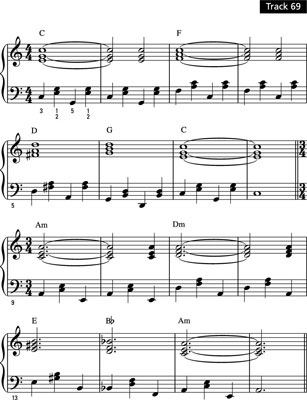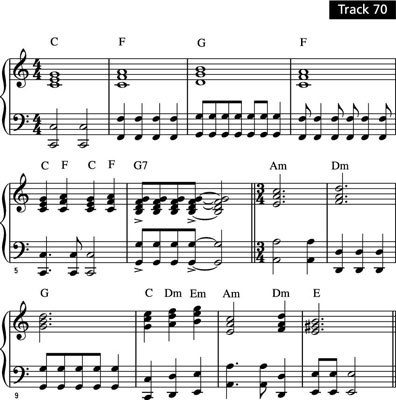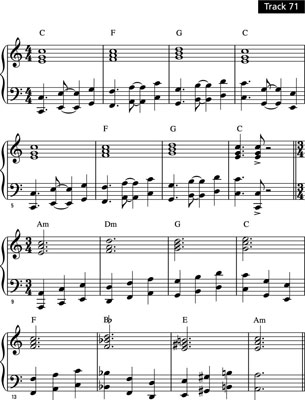One of the most important tools for your piano playing bag of tricks is a good supply of left-hand accompaniment patterns. Any time you’re faced with playing straight chords or even playing melodies from a fake book, you’re left to your own resources to supply an interesting-sounding bass line.
Try chord picking or octave hammering for that extra addition to your sound.
Have a look at these and other tracks in Chapter 16.
Chord picking
Left-hand chord picking is a style best suited to country music. But even if you aren’t a fan of that genre, you can apply this pattern to just about any song you like.
Most chords are made up of a root, a third, and a fifth. You need to know these three elements to be a successful chord-picker.
To play this pattern, break a chord into two units: the root note and two top notes. Play the root note on beat 1 and the top two notes together on beat 2. To make it more impressive, do something a little different on beat 3: Play the fifth of the chord by itself but one octave lower, which shows you four measures of this pattern with four different chords.

Now try playing this pattern in the piece “Picking and Grinning.” After you get the feel of this bouncy rhythmic pattern, you won’t even need to look at your hands. Your pinky will find the two alternating bass notes because they’re always the same distance from the root note.

Octave hammering
This easy (if tiring) left-handed groove is really fun and easy if your right hand is just playing chords. But if you’re playing a melody or something more complicated than chords with your right hand, this pattern may not be a practical choice.
To hammer out some octaves, you simply prepare your left hand in an open octave position, with your pinky and thumb ready on the two notes, and make sure your wrist is loose enough to bounce a bit with the appropriate rhythm.
When the chord changes, keep your hand in octave position as you move directly to the next set of octaves. You can play the octaves using any rhythm that sounds good to you — try whole notes, half notes, even eighth notes, depending on the rhythmic character of the song.
“Octaves in the Left” lets you roll out some octaves.

As you become more familiar with harmony, you can add to these left-hand octave patterns with octaves built on the notes of the chord. For example, the octaves in “Jumping Octaves” move from the root note to the third interval note to the fifth interval note for each right-hand chord.


